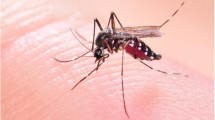Abstract
In a natural population ofOthnonius batesi Oll. at Glen Innes, N.S.W., 4.0% of larvae in 1972 and 2.2% in 1973 were exhibiting symptoms of virus infection, whilst 0.8% of pupae and adults from the same population were infected in 1972. These figures, and field observations of infected larvae, suggested that the pathogenicity of the virus was low. In laboratory experiments withO. batesi the infection had little effect on mortality, and no significant effect on duration of the first instar, food intake, or larval growth. The vast accumulation of virus in the fat body probably results in mortality prior to, or during, the pupal period. Temperature had a marked effect on both % infection (optimum 30°C) and production of viral spheroids (optimum 25°C). Very little viral development occurred below 20°C. In a host range study onlyO. batesi, Rhopaea verreauxi Blanch. andR. morbillosa Blkb. were infectedper os. The possible use of the virus as a control agent is discussed.
Résumé
Dans une population naturelle d'Othnonius batesi à Glen Innes, N.S.W., 4% des larves en 1972 et 2,2% en 1973 présentaient des symptômes d'infection virale, alors que 0.8% des nymphes et des adultes de la même population étaient infectés en 1972. Ces chiffres, et des observations de larves infectées faites sur les lieux, suggéraient que la pathogénie du virus était basse. Dans des expériences faites en laboratoire avecO. batesi, l'infection a peu d'effet sur la mortalité et aucun effet significatif sur la durée du premier stade, sur la consommation de nourriture ou sur la croissance larvaire. La forte accumulation de virus dans le corps gras entraîne probablement la mortalité avant ou pendant la période de nymphose. Latempérature a un effet marqué sur le pourcentage d'infection (optimum 30°C) ainsi que sur la production de sphéroides viraux (optimum 25°C). Très peu de développement viral s'est produit à 20°C. Dans une série complète d'études seulementO. batesi, Rhopaea verreauxi etR. morbillosa étaient infectésper os. L'usage possible du virus en tant qu'agent de contrôle est discuté.
Similar content being viewed by others
References
Bergoin, M. &Dales S. — 1971. Comparative observations on poxviruses of invertebrates and vertebrates. — In: Comparative Virology, (K. Maramorosch &E. Kurstak ed.), —Academic Press, New York & London, 169–205.
Bergoin, M., Devauchelle, G. &Vago, C. — 1969. Electron microscope study of the pox-like virus ofMelolontha melolontha L. [Coleoptera, Scarabaeidae]. —Arch. Ges. Virusforsch, 28, 285–302.
— — 1971. Electron microscope study ofMelolontha poxvirus: the fine structure of occluded virions. —Virology, 43, 453–467.
Bergoin, M., Veyrunes, J. C. &Scalla, R. — 1970. Isolation and amino acid composition of the inclusions ofMelolontha melolontha poxvirus. —Virology, 40, 760–763.
Bird, F. T., Sanders, C. J. &Burke, J. M. — 1971. A newly discovered virus disease of the spruce budworm,Choristoneura biennis [Lepidoptera: Tortricidae]. —J. Invertebr. Pathol., 18, 159–161.
Buckner, C. H. &Cunningham, J. C. — 1972. The effect of the poxvirus of the spruce budworm,Choristoneura fumiferana [Lepidoptera: Tortricidae], on mammals and birds. —Can. Entomol., 104, 1339–1342.
Devauchelle, G., Bergoin, M. &Vago, C. — 1971. Étude ultrastructurale du cycle de replication d'un entomopoxvirus dans les hémocytes de son hôte. —J. Ultrastruct. Res., 37, 301–321.
Goodwin, R. H. &Filshie, B. K. — 1969. Morphology and development of an occluded virus from the black-soil scarab,Othnonius batesi. —J. Invertebr. Pathol., 13, 317–329.
Goodwin, R. H. &Roberts, R. J. — 1975. Diagnosis and infectivity of entomopoxviruses from three Australian scarab beetle larvae [Coleoptera: Scarabaeidae]. —J. Invertebr. Pathol., 25, 47–57.
Granados, R. R. — 1973. Insect poxviruses: pathology, morphology and development. —Misc. Publ. Entomol. Soc. Am., 9, 73–94.
Heimpel, A. M. — 1971. Safety of insect pathogens for man and vertebrates. In: Microbial Control of Insects and Mites (H. D. Burges & N. W. Hussey, ed.), —Academic Press New York & London, 469–490.
Hurpin, B. &Robert, P. — 1967. Sur la spécificité deVagoiavirus melolonthae. —Entomophaga, 12, 175–180.
— — 1969. Recherches sur l'utilisation deVagoiavirus melolonthae pour la lutte microbiologique contre les vers blancs. —Entomophaga, 14, 349–357.
— — 1972. Comparison of the activity of certain pathogens of the cockchaferMelolontha melolontha in plots of natural meadowland.. —J. Invertebr. Pathol., 19, 291–298.
Hurpin, B. &Vago, C. — 1963. Une maladie à inclusions cytoplasmiques fusiformes chez le ColéoptèreMelolontha melolontha L. —Rev. Path. Vég. Entomol. Agric., 42, 115–117.
Moore, S. G. &Milner, R. J. — 1973. Quick stains for differentiating entomopoxvirus inclusion bodies. —J. Invertebr. Pathol., 22, 467–470.
Pogo, B. G. T., Dale, S., Bergoin, M. &Roberts, D. W. — 1971. Enzymes associated with an insect poxvirus. —Virology, 43, 306–309.
Roberts, P. — 1965. Sur quelques caractères de la virose à inclusions des larves du hanneton commun (Melolontha melolontha L., Col.Scarabaeidae). —C. R. Congr. Soc. Savantes, Nice, tome 2, 517–524.
— — 1968. Essais de laboratoire sur la conservation de la virulence deVagoiavirus melolonthae. —Entomophaga, 14, 159–175.
— — 1969. Étude en laboratoire de l'influence du stade larvaire, de la quantité de virus et de la température sur la virose aVagoiavirus deMelolontha melolontha L. [Coleopt.Scarabaeidae]. —Ann. Zool. Ecol. Anim., 1, 289–307.
Roberts, D. W. &Granados, R. R. — 1968. A poxlike virus fromAmsacta moorei [Lepidoptera: Arctiidae]. —J. Invertebr. Pathol., 12, 141–143.
Sutter, G. R. — 1972. A poxvirus of the army cutworm. —J. Invertebr. Pathol., 19, 375–382.
Author information
Authors and Affiliations
Rights and permissions
About this article
Cite this article
Milner, R.J., Lutton, G.G. The pathogenicity of an entomopoxvirus fromOthnonius batesi [Col.: Scarabaeidae] and its possible use as a control agent. Entomophaga 20, 213–220 (1975). https://doi.org/10.1007/BF02371662
Issue Date:
DOI: https://doi.org/10.1007/BF02371662




